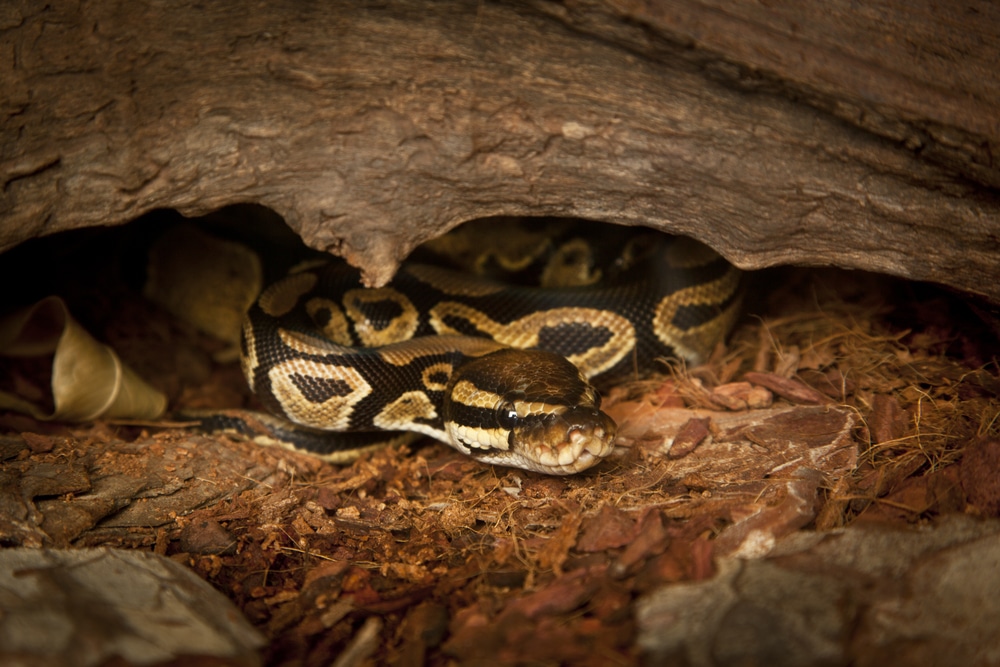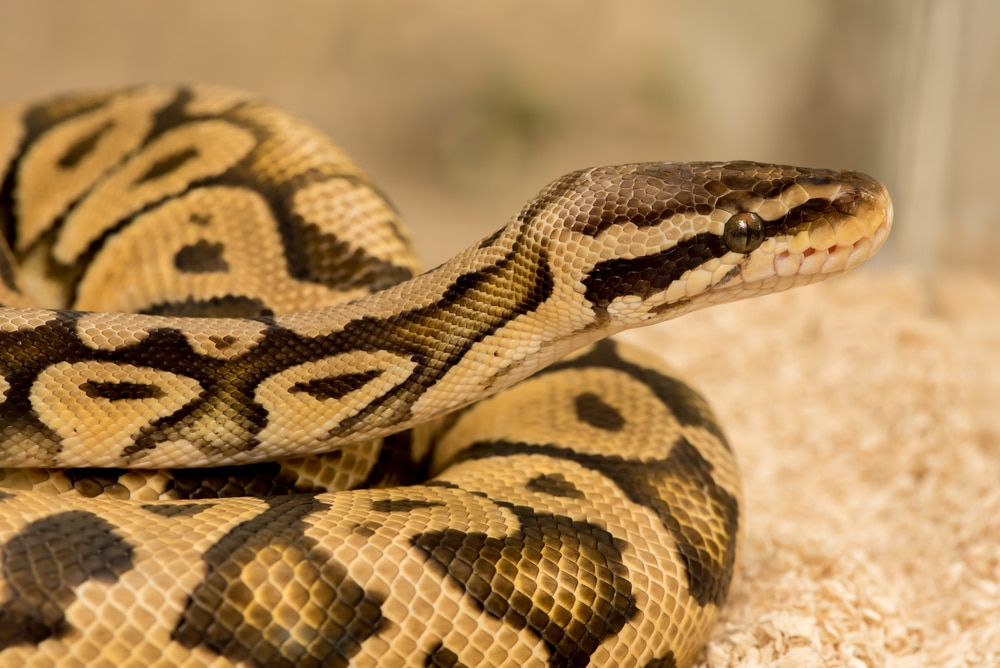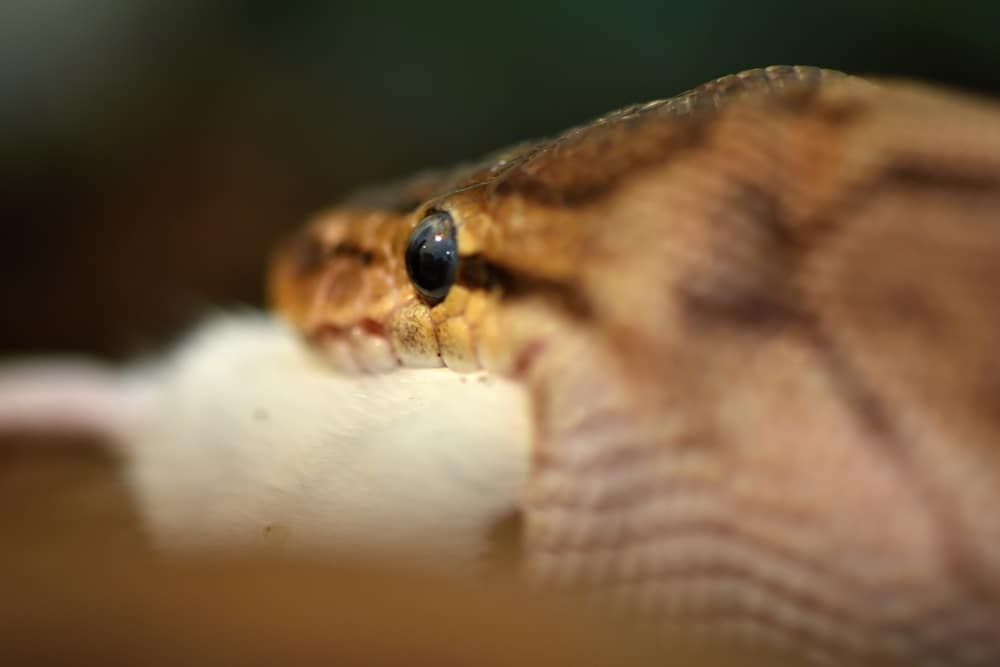Snakes are often advertised as being a low-cost pet – especially by those who’re in the business of selling snakes.
Make no mistake: When compared with dogs, cats, horses or other high-cost pets, snakes are relatively affordable. But they often cost far more than many new keepers suspect, which can lead to problems for people and their slithering pets.

We’ll try to help you avoid unexpected expenses below, by outlining the true costs associated with snake care. This will hopefully help keepers plan properly for their new pet or determine that they aren’t able to afford to do so, before ending up with a hungry snake and an empty bank account.
Quick Navigation
How Much Does a Pet Snake Cost: The Actual Animal
The most obvious cost associated with a pet snake is the actual animal. It’s also the easiest thing to budget for when considering bringing one home.
The price tag associated with different snakes varies wildly. Some species are relatively common and are therefore pretty affordable, while others are rare enough to garner five-digit price tags. Fortunately, most beginners tend to gravitate towards relatively common species, which can help keep their initial expenditures relatively low.
In concrete terms, you should expect to pay between $50 and about $300 for a suitable beginner’s snake.

Just note that a snake’s species is not the only thing that influences its price tag. The snake’s age, size, and sex will all come into play as well.
Generally speaking, older and larger animals will cost more than younger animals (at least, when discussing captive-bred individuals – the opposite trend often occurs with wild-caught animals). And because they’re more valuable to snake breeders, female individuals are usually more expensive than males.
If you want a snake that exhibits an unusual color pattern or is simply a particularly attractive individual, you’ll often have to pay more than you would a more typical specimen.
You may also find that different breeders and retailers price their animals differently, so don’t be afraid to shop around to find the best deal.
Your Snake’s Enclosure

Your snake’s enclosure is usually the most expensive item you’ll need to provide to your pet. In some cases, it may even cost more than the snake itself.
The price of your snake’s enclosure will vary based on a variety of factors, including:
- The type of enclosure. There are a variety of different enclosure types you can provide to your snake, including aquaria, plastic storage boxes, commercial reptile cages and custom-built enclosures. Generally speaking, storage boxes and aquaria are the most affordable options, while commercial reptile cages and elaborate, custom-built enclosures are the most expensive.
- The size of the enclosure. As you’d expect, larger enclosures are typically more expensive than smaller enclosures. Accordingly, and because you don’t want to be cruel to your pet by making him live in an excessively cramped habitat, it is wise to consider the enclosure size your snake will require when budgeting and selecting your animal.
- The features included in the enclosure. Many commercial reptile cages come in several different versions, which all include different features. Some are relatively simple enclosure without a lot of bells and whistles, while others are elaborate habitats that contain things like cord portals, built-in lighting or heating fixtures, and removable dividers. Enclosures that come with a lot of extra features almost always cost more than similar but simpler enclosures.
Ultimately, if you decide to use simple plastic storage boxes for your pet, you may only have to spend $20 to $50 on your pet’s enclosure. Conversely, if you decide to set your snake up with a large, complex and feature-packed enclosure, you may end up spending $500 or more, depending on the size of the habitat.
Personally, the author recommends that new keepers budget at least as much money for their pet’s enclosure as they intend to spend on the snake, and twice as much is even better.
Snake-Keeping Accessories
In addition to your snake’s enclosure, you’ll need a few accessories to keep him healthy and happy. Individually, none are terribly expensive, but collectively, they can represent a significant expense.
Some of the things most snakes will require include:
- Heating devices – The vast majority of snakes will require supplemental heating sources for their habitat. The exact costs you’ll incur vary based on the type of device you choose. Heating pads, heat cables and heat lamps are typically rather affordable, and shouldn’t cost you more than $20 to $40. Conversely, radiant heat panels – the preferred choice of many professional keepers – often cost $50 to $100.
- Thermometer – To ensure that your heating devices are maintaining proper temperatures, you’ll need to invest in a couple of thermometers. You’ll want an infrared non-contact thermometer to monitor surface temperatures, as well as a digital indoor-outdoor thermometer to monitor ambient air temperatures. You’ll likely spend about $50 to $100 on the pair, depending on whether you select budget-priced or premium models.
- Lighting fixtures – The vast majority of snakes will thrive with nothing more than ambient room light, so lights are rarely considered imperative for snake care. However, fluorescent light fixtures can help show off your snake’s colors, so some keepers add them anyway. Generally, you can obtain a fluorescent fixture and lamp for about $20, but large fixtures suitable for big enclosures will cost more.
- Substrate – You’ll need to place something on the bottom of the enclosure to help provide your snake with comfort and to absorb any released or spilled fluids. If you want to save money, you can use newspaper for most non-burrowing species. Alternatively, you can use cypress mulch, orchid bark, or several other options, but they’ll cost a bit more. Generally, you should be able to purchase a bag of substrate for less than $20, but you will have to replace them periodically. Additionally, large enclosures may require multiple bags.
- Hiding boxes – Almost all snakes require at least one hiding box, but most will gladly use a simple cardboard box. Nevertheless, commercial options (which often look quite nice) are typically available for less than $10 to $20, depending on the size.
- Plants – Plants aren’t a requirement for most snakes, but they are often a wonderful addition to your pet’s habitat, and they will often help keep your snake’s stress level low. Most plants useful in snake enclosures are relatively inexpensive and will cost about $5 to $20 each, depending on the size and species. Just note that you’ll likely want to include multiple plants, so be sure to budget accordingly.
- Water dish – Most snakes will require a water dish, but you needn’t spend a ton of money on one. If you’re inclined to keep your costs low, a simple plastic storage container will suffice. However, high-quality stainless-steel or ceramic water dishes are often the best choices, and they typically cost between $5 and $20, depending on the size.
- Misting bottle – If you select a snake that hails from a high-humidity environment, you’ll need to purchase a misting bottle or an automated misting system. Either approach will work, but the cost difference between the two is significant: A misting bottle will cost less than $5, while a misting system will likely cost at least $50 and likely much more.
Your Snake’s Food Costs

Because most snakes will thrive on a once-per-week feeding schedule, they are typically pretty affordable to feed. However, the actual costs will vary based on the size and prey species you purchase.
When purchased in bulk, mice are typically less than $1 each, and very young mice (pinkies and fuzzies) start at about $0.20 each. Rats are more expensive than mice, and very large rats may cost several dollars each. Rabbits and chicks are often similar in price to rats, although their price can vary significantly.
If you select a snake that requires foods like fish, frogs or lizards, you’ll likely find that their price varies wildly depending on the source. You may, for example, be able to find goldfish or minnows for $0.25 each, but you may have to pay $5 or more for lizards.
Once you determine the cost associated with each individual feeder, you’ll need to multiply it by the number of times you intend to feed your pet over the course of the year to arrive at your annual costs. For back-of-the-envelope calculations, you can assume that most snakes will require about 50 meals each year.
Veterinary Care
Veterinary care is undoubtedly the most common aspect of snake care that new keepers fail to budget for. And unfortunately, veterinary care can represent a significant cost. Further, veterinary care can be challenging to budget for, as you never know when your snake is going to fall ill or suffer an injury.
You’ll often find that a veterinary visit costs around $100, and you may spend many times this much if your snake needs complicated tests or procedures. In fact, you may receive a multi-thousand-dollar bill if your snake needs surgery or is forced to stay at the vet’s office for an extended period of time.
Given the unpredictable nature of veterinary care, it is wise for keepers to set aside a few hundred (if not a few thousand) dollars for these occasions. You can also look for a pet insurance plan that will cover snakes, as this may help reduce some of the costs you may incur.
Money-Saving Tips for Snake Keepers
Snakes are often more expensive than their owners initially expect, but there are a number of ways you can reduce these costs and save a bit of money. Some of the best things you can do include:
- Purchase your snake directly from a breeder rather than a retailer. By buying a snake directly from a breeder, you’ll be able to “cut out the middleman,” and acquire your snake for less than you would by buying it from a pet store or reseller.
- Be creative with hide boxes. Commercial hide boxes aren’t usually that expensive, but you can often save a bit of money by repurposing things like plastic plant saucers or storage boxes. Simply flip these types of items upside-down and cut a door in the side. You could also use old cardboard boxes, but you may have to discard them when they become soiled.
- Purchase your pet’s food in bulk. As long as your snake will accept pre-killed, frozen-thawed prey, you should always try to buy your pet’s feeders in bulk. Doing so will force you to allot some freezer space to your pet, but you’ll likely be able to cut your costs in half or more by doing so.
- Buy substrates from home improvement stores or garden centers. Pine bark, cypress mulch, orchid bark and similar substrates are often available for less in home improvement stores or garden centers than they are at retail pet establishments. Just be careful to ensure you are purchasing substrates that are clean and haven’t been treated with harmful chemicals.
- Be on the lookout for used heating or lighting equipment. As long as they’re in good shape, heating and lighting devices are often still useful when purchased used. By purchasing second-hand equipment, you’ll likely find it possible to spend only about half of what you’d need to on new equipment.
- Take advantage of sales. Like all other goods, snakes and the equipment you’ll need to care for them are often discounted from time to time, and budget-conscious buyers are wise to watch for these opportunities. Sales can occur at almost any time of the year, but they’re often most common during the late spring (when breeders are eager to sell any remaining offspring from the previous year) and shortly after the winter holidays.
Conclusion
As you can see, pet snakes often cost a bit more money than you may initially suspect. They’re certainly cheaper than many other pets, but that doesn’t mean they’re free. And to be a responsible owner, you must be able to budget appropriately to provide your pet with the care he deserves.
This doesn’t mean you need to be rich to keep a pet snake (especially not if you implement the tips we shared above) – but you will need to ensure you can afford to do so before bringing one into your home.